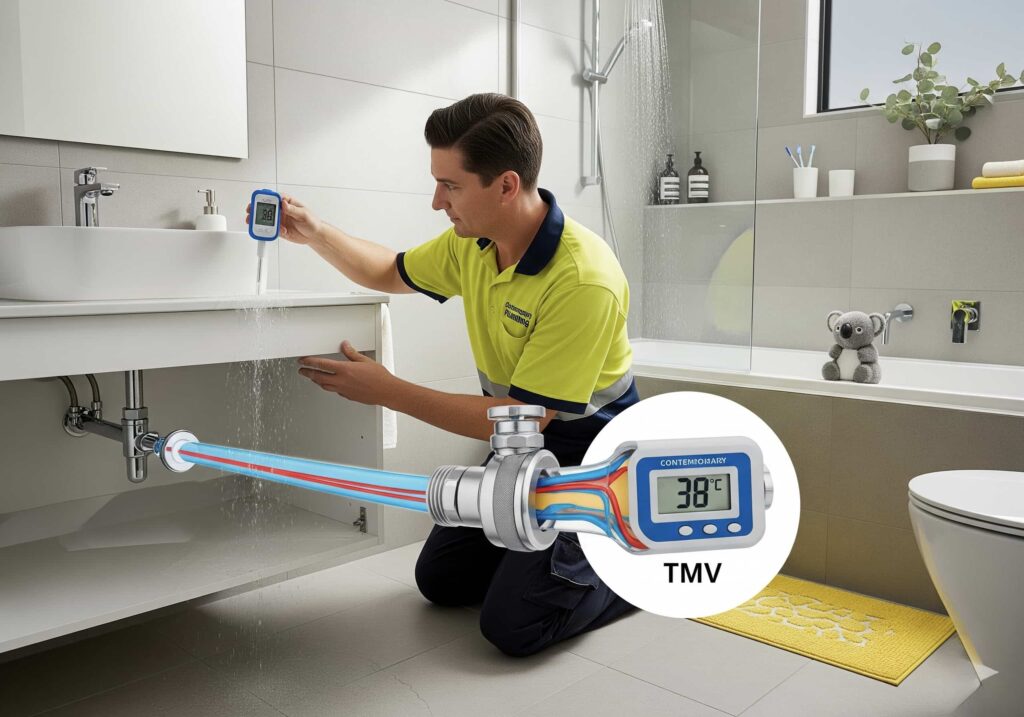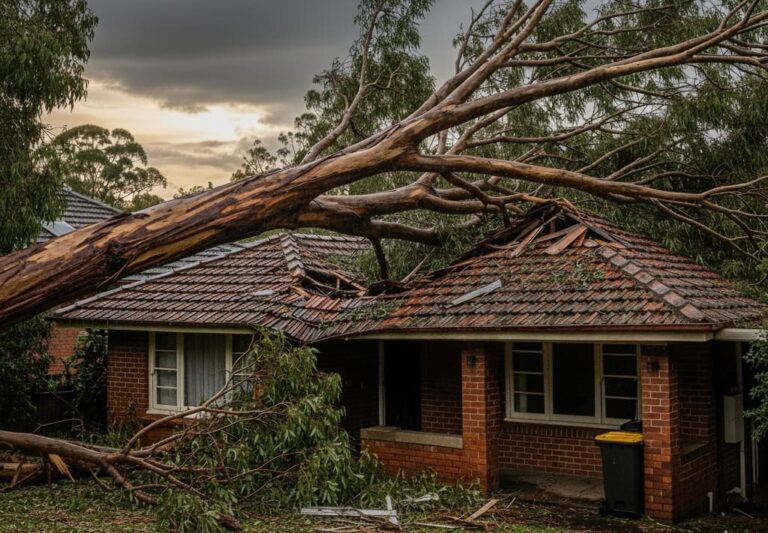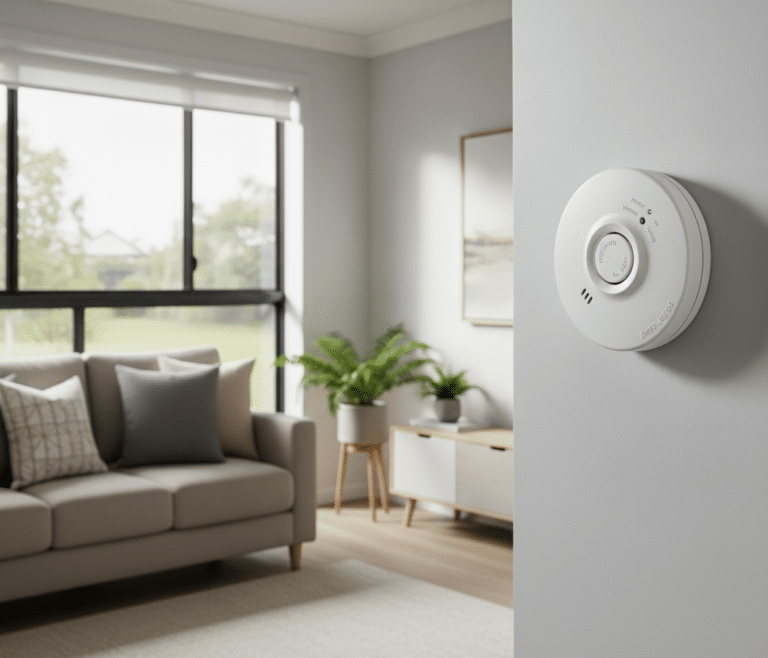A Quick Story: The Day the Shower Went Rogue
Picture this. You’ve hopped into the shower after footy training, ready for that perfect warm rinse. Just as you’re humming along, someone in the kitchen decides to do the dishes. Suddenly, the shower turns volcanic — like standing under a kettle. You jump out faster than a kangaroo on hot bitumen, yelling for a towel.
That’s exactly the kind of chaos a Thermostatic Mixing Valve (TMV) is built to stop.
So, What’s a TMV?
Think of it as a referee in your plumbing system. On one side, you’ve got steaming hot water that could brew tea. On the other side, freezing cold water that makes you gasp. The TMV stands in the middle, keeping the peace. It mixes the two just right so that what comes out of your tap or shower is safe, steady, and comfortable — no sudden lava blasts, no ice-bucket challenges.
Why Do Aussie Homes Need Them?
Australia takes hot water safety seriously. Without a TMV, taps can pour out water at over 70°C — hot enough to cause a serious burn in just a couple of seconds. Kids, grandparents, or even distracted adults can get hurt before they know what’s happened.
That’s why TMVs are mandatory in places like homes with kids, rental properties, aged care facilities, hospitals, and schools. The law says your water has to be stored hot (to kill bacteria like Legionella) but delivered cooler at the tap. The TMV is the clever gadget that makes this balancing act possible.
When Should You Worry About Yours?
Here’s the thing: TMVs aren’t a “set and forget” deal. Over time they get tired, just like smoke alarms or car tyres. If your shower water goes from warm to cold to hot within seconds, or you notice odd changes in pressure, that’s your TMV crying out for a check-up. In fact, Aussie standards say they should be tested every year to stay safe and compliant.
The Unsung Hero
You’ll probably never see your TMV. It hides behind walls or under sinks, quietly blending hot and cold like a barista making the perfect flat white. But without it, everyday things like bath time or morning showers could become dangerous.
So next time you’re enjoying that perfect hot shower, thank the hidden hero in the pipes. And if it’s been a while since a plumber last checked yours, don’t wait for the waterworks — give them a call.
The Science Behind the Comfort
Now, you might be wondering — how does this little gizmo actually pull it off? Imagine two taps running at once: one scalding hot, one ice-cold. If you tried to balance them by hand, you’d be twisting knobs back and forth like a DJ scratching a record, hoping you’d hit the sweet spot.
A TMV does that job automatically — but with precision. Inside the valve is a clever thermostat that constantly measures the water temperature. If the hot supply surges, the TMV instantly adds more cold. If the cold drops off, it eases back the hot. The adjustment happens so quickly that you don’t even notice. What you do notice is that your shower feels consistent, calm, and safe.
Why This Matters More Than You Think
It’s easy to shrug and think, “I’ll just be careful.” But the truth is, hot water accidents don’t give you much warning. For example, at 70°C, it only takes one second to cause a third-degree burn. That’s quicker than it takes to yelp and move away. For kids or elderly folks, the damage can be even worse.
TMVs take away the risk by capping the delivery temperature to around 50°C (for showers and taps) while still letting your hot water system store water hotter to keep bacteria like Legionella at bay. In other words, you get the best of both worlds: safety and hygiene.
When Rules and Real Life Collide
Let’s say you’re a landlord in Sydney, and you’ve just rented your place to a young family. The hot water system’s humming along fine, so you figure there’s nothing to worry about. But during a routine inspection, the property manager asks for proof that the TMV has been tested. You’ve got nothing on record.
Now you’re in a bind — because in many Aussie states, compliance isn’t optional. If a tenant’s child gets scalded, the lack of a certified TMV service could land you in serious hot water (pun intended). Insurance companies are quick to check whether safety standards were met. If you’ve skipped testing, that payout you’re counting on might vanish faster than a cold beer at a BBQ.
For homeowners, it’s the same story in a different flavour. A burst flexi hose can flood your cupboards, but a faulty TMV can turn bath time into an ER visit. Both are preventable if you keep up with regular plumbing checks.
The Cost of Neglect vs. The Price of Peace of Mind
Here’s the kicker: servicing a TMV is usually a straightforward, low-cost job. A licensed plumber tests the valve, adjusts it if needed, and signs it off. Compare that to the potential medical bills, insurance disputes, or legal headaches if something goes wrong, and it’s a no-brainer.
A little maintenance today buys you a whole lot of peace of mind tomorrow.
TMVs vs Tempering Valves — Clearing the Confusion
Here’s a little secret: a lot of Aussie homeowners (and even some tradies) confuse TMVs with tempering valves. They both mix hot and cold water, sure, but they’re not twins — more like cousins who show up to the same BBQ with very different jobs.
A tempering valve is cheaper, simpler, and often used in standard homes to cap water at about 50°C. It’s like a budget bouncer: does the job, but not great under pressure.
A TMV, on the other hand, is the high-performance pro — faster, more accurate, and legally required in places where safety is critical (hospitals, schools, rentals, aged care).
Here’s a quick cheat sheet to make it clear:
| Feature | Tempering Valve | Thermostatic Mixing Valve (TMV) |
| Accuracy | ±3°C | ±1°C (much tighter control) |
| Reaction Time | Slower | Fast — adjusts instantly |
| Where it’s used | Standard homes | Rentals, hospitals, aged care, schools |
| Cost | Lower | Higher, but with added safety |
| Legal Requirement? | Not always | Mandatory in many cases |
Why This Matters to You
Imagine you’re running bath time for the kids. With a tempering valve, the water might be around the right temp — but if the hot water surges, it takes a while to correct. With a TMV, the change is almost instant, so you don’t have a toddler suddenly screaming because the water went volcanic.
And that’s the big difference:
- Tempering valves are about meeting the basics.
- TMVs are about precision, compliance, and peace of mind.
So while you might not see the valve itself, the choice between them is really the choice between “near enough is good enough” and “I want this 100% safe and steady every single time.”
The Everyday Impact of a TMV
It’s easy to think of a TMV as just another plumbing gadget hidden behind a wall, but its impact plays out in daily life more than you realise. Imagine three different households:
- In a young family’s home, bath time is chaos enough without worrying about water suddenly going from perfect to painful. The TMV guarantees mum or dad can focus on keeping the bubbles in the tub, not testing the tap every two seconds.
- In an elderly couple’s unit, sensitive skin means even a slight jump in water temperature can feel extreme. A TMV keeps the shower steady and safe, letting them maintain independence without risking burns.
- In a rental property, the landlord might never set foot in the bathroom, but a faulty TMV could lead to insurance disputes if a tenant gets hurt. For them, it’s not just about safety — it’s about ticking the compliance box and avoiding a legal mess.
What Happens Inside the Valve
Think of the TMV like a little mechanical brain. Inside, a wax element or thermal sensor constantly measures the water temperature. If the hot surges, the valve shifts to let in more cold. If the cold slows down, it throttles the hot back.
The process is so fast and precise that you rarely notice it happening. All you feel is a consistent, comfortable flow — like your shower has a built-in autopilot.
Benefits You Can Actually Feel
Beyond ticking off safety regulations, here’s what homeowners really notice when a TMV is working as it should:
- Consistency – no more fiddling with taps to find the sweet spot every morning.
- Comfort – water temperature stays steady, even if someone runs the washing machine mid-shower.
- Safety – burns from scalding water become almost impossible.
- Confidence – especially for parents and carers, knowing the system itself is protecting the vulnerable.
The Numbers That Tell the Story
- 70°C – typical hot water tank storage temp (kills bacteria, but scalds in 1 second).
- 50°C – maximum safe delivery temp at taps/showers in Aussie homes.
- 1°C – the tight control TMVs can maintain.
That tiny difference — a few degrees either way — can mean the difference between a relaxing shower and an emergency room visit.
Frequently Asked Questions About TMVs
Q: What exactly does a Thermostatic Mixing Valve do?
A TMV mixes hot and cold water to deliver a steady, safe temperature at your taps and showers. It reacts instantly if the hot or cold supply changes, so you don’t get scalded or frozen mid-shower.
Q: Do all Aussie homes need a TMV?
Not every single home — but in many cases, yes. They’re legally required in places like rental properties, hospitals, schools, aged care facilities, and any home with vulnerable occupants like children or elderly people. Even if it’s not strictly mandatory, most homeowners choose one for safety and comfort.
Q: How is a TMV different from a tempering valve?
A tempering valve is a simpler device that mixes hot and cold water but with less accuracy. A TMV is faster, more precise, and required where safety is critical. Think of a tempering valve as “basic cover” and a TMV as “premium protection.”
Q: How often should I service my TMV?
Australian standards recommend annual servicing. Over time, valves can wear out, clog, or lose accuracy. A quick yearly check from a licensed plumber keeps everything compliant and safe.
Q: What happens if my TMV fails?
You could get inconsistent water temperatures, scalding hot water, or even insurance headaches if an accident happens. The good news? Regular servicing spots problems before they become serious.
Q: Is servicing expensive?
Compared to the risks, no. TMV servicing is a small, straightforward job. Most plumbers can do it quickly and provide certification for peace of mind.
The Final Word: A Hidden Hero Worth Checking On
You’ll probably never brag about having a Thermostatic Mixing Valve. It’s not the kind of thing you show off at a BBQ, like a new deck or a fancy fridge with an ice dispenser. But the truth is, your TMV quietly does more to protect your family than almost any other bit of plumbing gear in your home.
Think about it: every single shower, every bath, every time the kids wash their hands — it’s there, balancing water like a tightrope walker. It never asks for thanks, but it does ask for a little attention now and then. Just like a car needs servicing, your TMV needs a regular check to make sure it’s working properly. Ignore it, and you risk sudden shocks, compliance headaches, or even serious accidents.
Here’s the good news: servicing a TMV is quick, affordable, and leaves you with total peace of mind. A licensed plumber will:
- Test the temperature accuracy.
- Check for wear, corrosion, or blockages.
- Adjust or replace parts if needed.
- Certify that your system is compliant with Aussie standards.
It’s the difference between hoping your hot water is safe and knowing it is.
If it’s been a while since your TMV was checked, don’t wait for surprises. A quick service from a licensed plumber will keep your hot water safe, steady, and compliant. The team at Contemporary Plumbing can test, service, or replace your TMV so you can enjoy worry-free showers every day.




